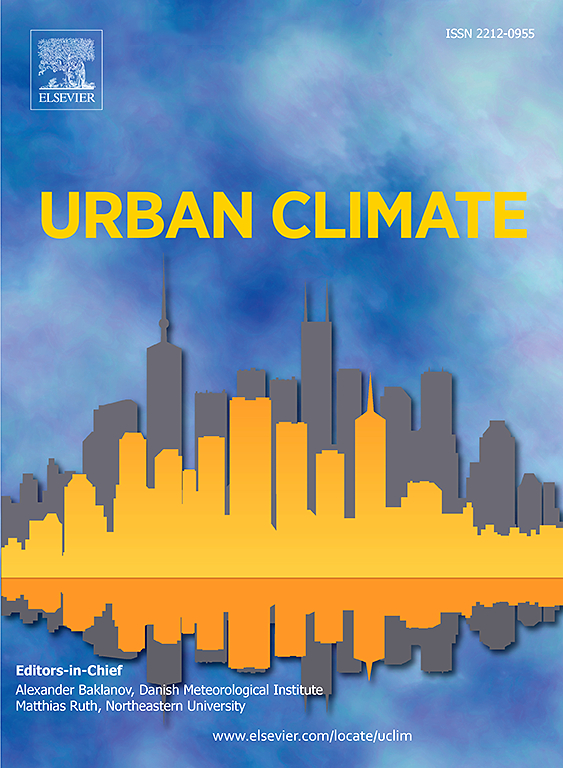美国相邻城市地区允许对流的水文气候模型评估
IF 6
2区 工程技术
Q1 ENVIRONMENTAL SCIENCES
引用次数: 0
摘要
在天气和气候模式中准确表示城市地区对于模拟城市表面和大气边界层之间的相互作用至关重要,特别是在解决深层对流的高分辨率区域模式中。然而,许多大陆尺度模拟都使用了简化的城市参数,这就对其再现城市水文气候的能力提出了质疑。本研究评估了 CONUS404--美国地质调查局-国家空研中心(USGS-NCAR)最新的 4 千米对流允许水文气候建模数据集--在美国大陆(CONUS)城市地区的应用情况。我们利用观测数据对 2011 年至 2020 年期间 208 个城市站点和 342 个非城市站点的每小时近地表气温、露点和风速模拟进行了评估。结果显示,CONUS404 对城市地区气温的模拟效果更好,在城市站点平均偏暖(0.08 °C),在非城市站点平均偏冷(-0.52 °C)。露点模拟在城市站点表现出较强的干燥偏差,表明城市植被的蒸散作用未得到充分反映。风速一般被低估,城市站点平均偏差为-0.74 m s-1,非城市站点平均偏差为-0.35 m s-1。季节分析表明,冬季温度和露点的模型误差较大,这与城市部分有很大关系。这些发现凸显了 CONUS404 中大量城市参数化的局限性,强调需要加强城市表征以改进大陆尺度的水文气候模拟。本文章由计算机程序翻译,如有差异,请以英文原文为准。
Assessment of convection-permitting hydroclimate modeling in urban areas across the contiguous United States
Accurate representation of urban areas in weather and climate models is crucial for simulating interactions between urban surfaces and the atmospheric boundary layer, especially in high-resolution regional models that resolve deep convection. However, many continental-scale simulations use simplified urban parameterizations, raising questions about their ability to reproduce urban hydroclimate. This study evaluates CONUS404—a recent USGS-NCAR 4-km convection-permitting hydroclimate modeling dataset—in urban areas across the contiguous United States (CONUS). We assessed hourly near-surface air temperature, dewpoint, and wind speed simulations at 208 urban and 342 non-urban station locations from 2011 to 2020 using observations. Results show that CONUS404 performs better for air temperature in urban areas, with a slight mean warm bias (0.08 °C) at urban stations and a mean cold bias (−0.52 °C) at non-urban stations. Dewpoint simulations exhibit stronger dry biases at urban stations, suggesting underrepresented evapotranspiration from urban vegetation. Wind speed is generally underestimated, with average biases of −0.74 m s−1 at urban and −0.35 m s−1 at non-urban stations. Seasonal analyses reveal larger model errors for wintertime temperature and dewpoint that strongly depend on urban fraction. These findings highlight the limitations of the bulk urban parameterization in CONUS404, underscoring the need for enhanced urban representations to improve continental-scale hydroclimate simulations.
求助全文
通过发布文献求助,成功后即可免费获取论文全文。
去求助
来源期刊

Urban Climate
Social Sciences-Urban Studies
CiteScore
9.70
自引率
9.40%
发文量
286
期刊介绍:
Urban Climate serves the scientific and decision making communities with the publication of research on theory, science and applications relevant to understanding urban climatic conditions and change in relation to their geography and to demographic, socioeconomic, institutional, technological and environmental dynamics and global change. Targeted towards both disciplinary and interdisciplinary audiences, this journal publishes original research papers, comprehensive review articles, book reviews, and short communications on topics including, but not limited to, the following:
Urban meteorology and climate[...]
Urban environmental pollution[...]
Adaptation to global change[...]
Urban economic and social issues[...]
Research Approaches[...]
 求助内容:
求助内容: 应助结果提醒方式:
应助结果提醒方式:


